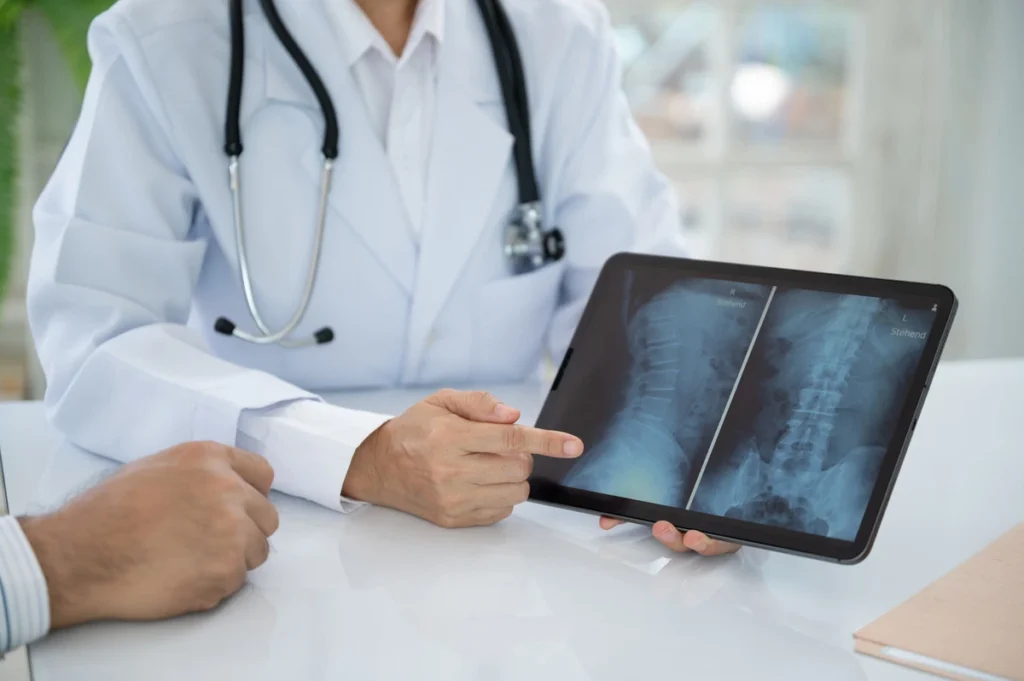
A thoracic herniated disc occurs when one of the discs in the mid-back region bulges or ruptures, pressing on nearby nerves or the spinal cord. The thoracic spine consists of 12 vertebrae (T1–T12) that support the upper and middle back, provide stability, and protect vital organs such as the heart and lungs.
Common causes include degenerative disc disease, which gradually weakens the discs over time, as well as trauma from accidents or sports injuries. Repetitive stress from certain activities, such as heavy lifting or poor posture, can also contribute to the development of the condition. In some cases, natural age-related wear and tear or underlying spinal conditions can accelerate disc changes, leaving the area more vulnerable to injury.
Risk Factors of a Herniated Thoracic Disc
Risk factors include age, high-impact physical activity, and pre-existing spinal conditions. Occupations or hobbies that involve repetitive lifting or twisting may also raise the likelihood of developing a herniation. Genetics can play a role as well, predisposing some individuals to earlier disc degeneration.
What Are the Symptoms of a Thoracic Herniated Disc?
Early diagnosis is critical, as timely treatment can significantly improve outcomes and prevent long-term complications. To that end, recognizing issues such as T5-T6 herniated disc symptoms or T11-T12 disc herniation symptoms early on can make a major difference in recovery, helping patients seek care before nerve compression leads to lasting damage.
Thoracic herniated disc symptoms can vary depending on the location and severity of the herniation. Pain is often felt in the mid-back and may radiate to the chest, abdomen, or even legs. Because the thoracic spine is connected to the rib cage and internal organs, the pain pattern can sometimes be confusing and mistaken for heart, lung, or gastrointestinal problems.
Nerve-related symptoms may include numbness, tingling, muscle weakness, and even coordination difficulties. Over time, patients might notice difficulty with balance or reduced endurance for everyday activities. Specific disc levels can produce unique presentations. For example:
- T3-T4 disc herniation symptoms can affect the upper back and shoulder regions.
- T5-T6 herniated disc symptoms may cause discomfort radiating into the chest.
- T6-T7 bulging disc symptoms may create pain that mimics cardiac or gastrointestinal issues.
- T11-T12 disc herniation symptoms may extend pain into the lower abdomen or legs.
Some patients ask, “Can a herniated disc cause vomiting?” And the answer is yes, when spinal cord compression affects autonomic pathways. Similarly, “Can a herniated disc cause breast pain?” is another valid question that is frequently asked, as thoracic nerve irritation can sometimes present as unusual referred pain. Other uncommon symptoms may include hypersensitivity in the torso or difficulty breathing comfortably, further complicating diagnosis.
Seek immediate medical care if you experience severe weakness, loss of coordination, or signs of spinal cord compression. Early intervention can prevent progression and protect long-term spinal health.
Diagnosis: How Is a Thoracic Herniated Disc Identified?
Diagnosis begins with a detailed medical history and physical exam. Your physician will assess your pain patterns, reflexes, and motor function to identify possible nerve involvement and better understand your thoracic herniated disc symptoms. During this stage, doctors often ask about daily activities, recent injuries, or family history of spine problems, since these details can provide important clues about the underlying cause.
Advanced imaging plays a vital role. MRI is often the gold standard for confirming a thoracic herniated disc, while CT scans may be used in complex cases or when MRI is not possible. In some situations, additional tests such as X-rays or nerve conduction studies may be ordered to rule out other conditions. Neurological evaluations help pinpoint affected nerve roots and assess the severity of symptoms, which is critical for developing an effective plan.
For complex cases, consulting with true spine specialists, such as Goodman Campbell, ensures the most accurate diagnosis and treatment planning. These experts often collaborate across disciplines — combining the insights of radiologists, neurologists, neurosurgeons, and interventional pain management physicians — to ensure a complete picture of the patient’s condition. A thorough evaluation also helps determine whether a conservative thoracic disc bulge treatment is sufficient or if a more advanced surgical intervention may be necessary.
How Do You Treat a Thoracic Herniated Disc?
Treatment depends on the severity of the condition. Many patients improve with conservative approaches such as rest, physical therapy, and modifying daily activities. Targeted exercises can strengthen supporting muscles and improve spinal stability, forming the foundation of a nonsurgical thoracic disc bulge treatment plan. Physical therapy may include stretching to improve flexibility, strengthening routines for core and back muscles, and posture training to reduce undue stress on the thoracic spine.
Interventional pain management physicians may use epidural steroid injections or nerve blocks to reduce inflammation and provide relief, particularly for patients who have not responded fully to more conservative care. These minimally invasive options can provide valuable time for natural healing to occur while reducing daily discomfort. Medications may also be recommended to help manage pain and stiffness, supporting mobility during recovery.
Lifestyle adjustments play an important role: proper hydration, balanced nutrition, and adequate rest all support spinal health and healing. Sleep positioning is also key. Patients often ask how to sleep with a thoracic herniated disc. Using a supportive mattress and sleeping on your back with a pillow under your knees can reduce spinal pressure, while side sleepers may benefit from a pillow between their knees for alignment.
In severe or unresponsive cases, surgery may be considered. Surgical options range from minimally invasive decompression to more complex fusion procedures, depending on the level of damage and nerve involvement. At Goodman Campbell, our expert teams personalize treatment plans, carefully weighing risks and benefits while ensuring each patient understands their options. Many patients reclaim independence, mobility, and activity levels after expert care, often returning to the activities they worried they might have to give up permanently.
What Not to Do With a Thoracic Disc Herniation
Certain activities can worsen symptoms or delay recovery. Avoid heavy lifting, twisting motions, or high-impact sports until cleared by your doctor. Even simple household tasks such as shoveling snow, moving furniture, or carrying heavy grocery bags can put unnecessary strain on the thoracic spine and aggravate the condition. Repetitive bending or prolonged sitting without proper back support may also contribute to further irritation. Relying on pain medications or seeking “quick fix” remedies without guidance from your healthcare provider can lead to complications and worsen outcomes.
Delaying care is another risk. Ignoring pain or neurological symptoms may allow the herniation to progress, potentially causing permanent nerve damage. For example, tingling or numbness in the chest or abdomen that goes unchecked may develop into muscle weakness or coordination problems over time. Instead, partner closely with your care team. They can provide safe activity modifications, guide you through appropriate therapy, and monitor your progress. Following medical advice and adhering to your personalized treatment plan give you the best chance for a successful recovery, while also helping prevent future flare-ups.
How Long Does It Take for a Thoracic Herniated Disc To Heal?
Healing time varies depending on the severity of the herniation. Mild cases may improve within weeks, while moderate cases can take several months. Severe herniations may require surgical treatment and longer rehabilitation, especially if there has been significant nerve compression. Even after surgery, structured physical therapy and lifestyle modifications play a critical role in restoring function and preventing recurrence.
Recovery also depends on individual factors such as overall health, activity level, and adherence to treatment plans. Younger patients or those with strong baseline fitness may heal more quickly, while individuals with other health challenges — including osteoporosis, arthritis, or diabetes — may need additional time. Maintaining consistent communication with your care team ensures that adjustments can be made if progress slows. Patients who follow medical guidance closely, attend therapy sessions, and practice daily spine-friendly habits often experience faster and more complete improvement.
Hearing inspirational recovery stories can help. Many people with a thoracic herniated disc regain strength and mobility with expert care. Some are able to return to work, hobbies, and family activities they feared losing. Persistence, patience, and partnering with experienced specialists are crucial to achieving these kinds of outcomes. If you are facing this challenge, request an appointment or ask your doctor about Goodman Campbell for expert support throughout your recovery journey.
Hope and Healing With Goodman Campbell
A thoracic herniated disc may feel overwhelming, but understanding its causes, symptoms, and treatments empowers you to take control of your health. These conditions often arise from age-related changes, repetitive stress, or sudden injuries, and recognizing early warning signs — localized back pain, numbness, tingling, or weakness in the torso or legs — can make a significant difference in outcomes. With early diagnosis, evidence-based care, and the right support, recovery is possible, and many patients regain mobility and quality of life.
At Goodman Campbell, spine specialists are dedicated to helping patients reclaim comfort and function. Using personalized treatment plans that may include physical therapy, minimally invasive procedures, and lifestyle guidance, along with advanced diagnostic imaging, our care teams address each patient’s unique needs. Our compassionate approach ensures patients are heard, supported, and empowered every step of the way.
If you or a loved one experiences symptoms, don’t wait to seek help. Take the first step today: either request an appointment or ask your doctor about Goodman Campbell and begin your journey to lasting health, restored mobility, and renewed confidence in daily life.


